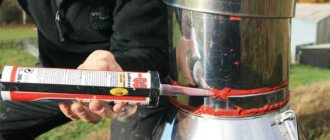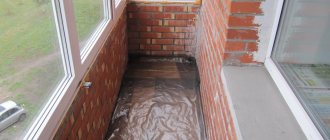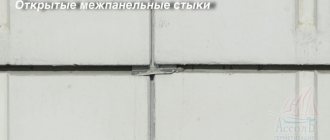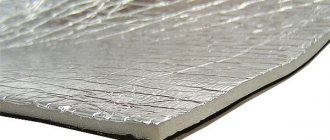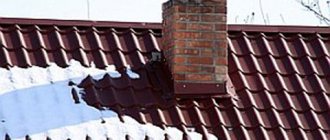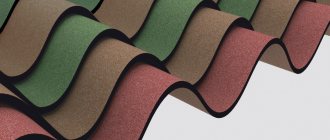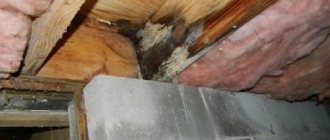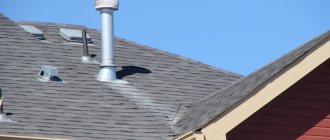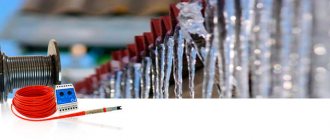Why are roofing sealants needed?
Sealants can be used both as a building material and as a repair agent for roof maintenance.
Using this material you can carry out the following roofing work:
- Seal seams between individual roofing elements. Most often, this is needed on roofs with a small slope angle.
- Seal joints in areas where the roofing material comes into contact with other coverings.
- Eliminate cracks in the area of chimney ducts, drainpipes, ventilation shafts, communications and other elements that cause a violation of the integrity of the roofing covering.
- Treat skates located on a slope.
- Prevent cold bridges.
- Carry out quick sealing of leaks.
The most popular are six types of roofing sealants
Areas of possible roof leaks.
Very rarely does a roof leak at the ridge of the roof. The lower you are from the roof ridge, the more likely it is that there will be leaks at the roof seams. Roofs leak in places where water can be trapped, such as: - Valleys and other interior corners of the roof. — At the junctions of the roof and façade walls. — In gutters, especially on attic roofs. Sealing the roof in many cases eliminates the problem of roof leaks. However, if the roof is not regularly cleared of snow during the winter, ice can expand the roof seams and the incoming heat through the roof joints will melt the snow and ice. In this case, the sealing of the roof may be broken and leaks will resume.
Sealing tapes
An inexpensive and effective means of roof protection. This material withstands low temperatures and exposure to the sun. It is very easy to install, and just as easy and quick to remove if replacement is necessary. The bitumen layer created in this way is characterized by good thickness and tightness. It is very resistant to mechanical stress and has good durability.
The tape is often used as a repair patch on bitumen roofing. With its help, it is convenient to insulate junctions, seal vapor barrier material, and repair seam metal roofs and drainage systems. The use of sealing tape is especially suitable for those new to roofing work. It is used to waterproof seams and joining areas. In application, the tape is very similar to regular tape.
Roof waterproofing.
Roof waterproofing: sealing roof joints and abutments, sealing roof seams will certainly eliminate leaks. But you need to understand that if there are existing defects in the roof structure, this is a temporary measure. Therefore, it is necessary to qualitatively inspect the condition of the roof truss system, the condition of the seam locks, and gutters. If defects in the roof truss system lead to gaps between roofing elements, then despite the deformability of the sealant, after some time leaks through the roof covering may appear again. Therefore, to eliminate leaks for a long time, it is necessary to carry out high-quality repairs of all roof elements. But if funds are not provided for major roof repairs, sealing seams, joints and gaps of the roof is a good temporary measure to eliminate roof leaks.
TOP
Bitumen sealant
Metal roofs made of corrugated sheets, metal tiles, etc. are most often sealed using bitumen sealant. The material can also be used on tiled and roofing felt roofs. Bitumen sealant for roofing is quite toxic and not very resistant to high temperatures (read: “Types of roofing bitumen sealants, rules of use, methods of application”).
As for the strengths of this rather elastic sealant, it is first of all worth highlighting its high strength and moisture-resistant characteristics. Bitumen sealants can be laid not only on dry, but also on wet substrates, with the possibility of subsequent painting to match the overall coating.
Roofing paint application
Roofing paint has many opponents who consider such coatings to be extremely unreliable and short-lived. But since they were invented, it means that there is a certain meaning in their use.
The photo shows a roof that was painted for 4 years. The paint was applied to galvanized iron, which had already been painted several times.
The key to success when painting a standing seam roof is careful preparation of the surface and following the paint manufacturer's recommendations.
In the photo we see a seam roof before being prepared for painting.
CONAN FORUMHOUSE user
Intermediate processing: cleaning with a metal brush (attachment to an angle grinder), removing a thin layer of oxidized paint and peeling flakes. Cleaning of corrosion areas is carried out to a layer of pure metal.
Before painting, the surface was degreased with white spirit. The result is in the photo.
The user belmax used a slightly different surface preparation sequence:
- Cleaning off rust with a wire brush.
- Treatment with anti-corrosion compound.
- Washing the roof with ordinary water (the author of the technology waited for heavy rainfall, but for these purposes you can use a regular car mini-wash).
Painting was done with paint that prevents the formation of rust.
belmax FORUMHOUSE user
The house survived the end of summer, autumn, winter of 2012, as well as spring and summer of 2013. In principle, the result is satisfactory. If it lasts for 5 years without major damage to the paint, it means it turned out exactly what I wanted.
Rubber and silicone
For the sale of silicone mixtures, both standard packaging for pistols and buckets can be used, which makes it possible to apply the substance with modern spray guns and construction rollers. Roofing silicone is one of the most popular materials of this type.
The fact is that this universal material is not afraid of significant fluctuations in air temperature and direct sunlight. Once applied, silicone roofing sealant hardens quickly. It is used for both temporary and permanent purposes. Silicone-type compounds can be acetic or neutral. The latter option is not as durable as the first, but does not emit toxic substances and is practically odorless.
How to apply bitumen sealant during construction work
Factories produce roof sealant in various packaging. Metal cans and tubes are the most popular due to their convenience and practicality. The latter are excellent for working with narrow seams and cracks. When applying sealant, you should use a special gun. It will greatly facilitate the sealing process and allow it to be completed without wasting extra mixture. It also allows access to difficult and hidden seams or cracks. The product, sold in cans or plastic buckets, should be applied in layers using a spatula. Excess sealant must be removed. However, it is worth paying attention to the fact that it is advisable to buy such packaging only if there is a large amount of work to be done.
For a certain number of jobs, you can select a specific container with sealant Source asuncion.alpens.ru
Acrylic
This type of sealant is very similar to the previous one, at a lower cost. In addition, to apply it, the surface to be treated must be thoroughly dried. The advantages of the material include the complete absence of solvents and odor during use.
If you want to achieve maximum invisibility of the treated area, this will be quite easy, thanks to the significant color range of acrylic sealant. When using this material for roofing work, one should take into account its low waterproofing characteristics. This is explained by the presence of aqueous dispersion in the acrylic composition. To solve this problem, it is recommended to use joint tape in parallel with acrylic sealant.
Waterproofing tape
This material is also often called “sealant tape”. Its direct purpose is to seal cracks in roofing materials, gutters, and water inlet gutters. As a rule, the tape consists of two layers. The top one is metal foil, resistant to ultraviolet radiation and precipitation. The bottom one is adhesive, made of bitumen, polymer or a composition thereof. Fixing a hole in a metal roof couldn't be easier. You just need to cut a piece of the desired size, glue it over the hole and roll it with a roller. After this, the patch needs to be painted in the color of the roof.
Polyurethane
Polyurethane sealant is based on polymerized resins, the production of which will require special conditions. The result is a viscous and fluid substance that can be easily processed on any surface.
This type of sealant is quite toxic and the most expensive: the cost of purchasing it is fully compensated by the high performance characteristics of the material. In this case, sealing can be carried out in fairly severe frosts; The substance is easy to apply and hardens quickly. The resulting surface effectively serves for a long time, withstanding mechanical stress, moisture and corrosion. Any substrate is suitable for applying polyurethane sealant.
Sealing of roof seams.
The roof of any building wears out. The load-bearing structures of the roof sag and deform under the load of snow and ice. Roof seams, joints and abutments are deformed and diverge. Before winter, routine diagnostics and subsequent sealing of the roof seams should be carried out. All seams of galvanized roofing must be coated with sealing mastic. Sealing seams of the roof, as well as joints and abutments to the facade, will protect against moisture penetration and ice will not destroy the roof.
Two-component
The two-component mixture is based on silicone rubber, the ingredients of which are adhesive paste and a special hardener. The shelf life of this sealant until the moment of application is quite significant, however, after mixing the individual components, the sealant must be applied within a certain time, otherwise the polymerization process will begin.
The two-component composition is quite convenient to apply, and this can be done at temperatures from -25 to +40 degrees. As for the temperature stability after the substance hardens, it ranges from -70 to +70 degrees. Rubber roofing sealant adheres well to metal, concrete, plastic, brick surfaces, and the resulting seam after sealing is characterized by strength and smoothness.
Sealing a transparent roof
The joints of translucent roofs are treated with sealants with a curing or non-curing structure. There are also special elastic profiles that allow you to make a sealed joint of a transparent roof. The choice of sealing method and material depends on the type of structure with its expected future loads. For example, glass greenhouse roofs are optimally sealed with structural silicone. The paste adheres perfectly to glass without losing its high insulating properties for a long time. Transparent roofing is subject to wind and snow loads, which is important to consider when choosing a sealant.
Mastic
Along with the above sealants, the roof can also be treated with mastic. To produce this viscous plastic mass, you will need to mix binders and fine fillers such as carbon black, talc, graphite, etc.
The material also contains special additives. By dosing different components when mixing, you can give the substance the required characteristics. Waterproofing is mainly carried out with bitumen mastic, however, if we are talking about the installation of roll materials, a more expensive polymer version can also be used.
When should you use sealant for corrugated roofing?
The polymer-coated corrugated sheet itself is one of the most reliable and durable roofing materials. But when installing any roof, and especially when installing roofs of complex configurations, you cannot do without additional sealing of individual sections.
Such areas include various types of junctions with building structures, roof windows and places where smoke and ventilation ducts pass through the roof. In addition, if the roof slope is less than 12°, it is mandatory to seal the corrugated roof at all transverse joints. Sometimes it is necessary to process longitudinal overlaps - in this case, the sealant, if possible, is applied to the upper part of the wave.
The sealant is also used at the junction of the corrugated sheeting and the roof ridge. In this case, the corrugated sheet wave is filled with the composition by approximately half. This allows you to avoid water getting under the roof during slanting rain. In this case, there remains a gap between the ridge and the corrugated sheet, sufficient for air circulation under the roof.
Metal roofing
It is best to seal a metal roof with a material that has the following properties:
- Elasticity.
- Resistant to precipitation.
- Good adhesion to metal surfaces.
- Ability to withstand vibration well.
Having carefully studied the question of which sealant to choose for corrugated sheets, you can come to the conclusion that polyurethane and bitumen-rubber type substances are most suitable in this case. The metal surface, before applying them, must be thoroughly cleaned, dried and degreased.
In case of urgent repairs, a metal roof sealant is selected that can be applied to a wet base. Corrugated sheeting and metal tiles have similar characteristics, so the process of sealing them is identical. In addition, roofing sealants for corrugated sheets can be successfully used on other types of metal roofs.
In order for the sealing of a corrugated roof to be reliable and durable, the following procedures should be carried out:
- Carefully check all joints before applying sealant. If necessary, clean and dry them.
- To apply sealant to a corrugated roof, an even layer of 2-3 mm is used. In this case, polyurethane tape will not be superfluous.
- The work must be carried out in dry, warm weather, since sealant for roofing with corrugated sheets does not react well to humidity.
Regarding the application of sealant to metal roofing, the following recommendations will be required:
- Gaps up to 5 mm are sealed with silicone sealant. For this purpose, a composition is selected that tolerates sunlight well.
- All roofing joints need to be treated, both longitudinal and transverse. It is also important not to forget to seal the ventilation duct, antenna outlet and chimney.
Selection of sealant
How to find out which sealant is suitable for any individual case?
Different types of sealants are noticeably distinguished by their own performance qualities. Some types may be ideal for a particular type of coating, and be almost unsuitable for a completely different one.
Let's look at the most common of them, suitable for various types of roofing.
Sealants for metal roofing
For this type of roofing, you need products with the following qualities:
- reliable adhesion to metal;
- greater flexibility factor;
- good vibration resistance;
- resistance to atmospheric precipitation.
These properties are best met by bitumen-rubber sealants and polyurethane sealants, which can maintain high elasticity throughout their entire service life. Before starting work on finishing the metal coating, the areas where the substance is applied must be thoroughly degreased and dried. In case the roof
needs urgent isolation, a composition that can be applied to a damp surface will be most suitable.
You need to know that the use of silicone insulation on a metal roof can directly cause rust.
In terms of its own qualities, metal slate is very similar to metal roofing tiles . Thanks to this, they are sealed in a similar way. A much more possible roof slope should be 14 degrees. Transverse joints of profile panels must be given special attention. For such a roof, sealants based on silicone and polyurethane are best suited for their performance characteristics.
Sealing corrugated roofing
In order to implement proper sealing of a roof made from profiled decking, it is important to do the following.
- At the beginning of the procedure, check the joints - you can only work with dry and clean surfaces.
- Apply sealant to the metal slate covering in an equal layer approximately 3 mm thick. You can use polyurethane-based tape.
- All activities are carried out at good temperatures and in relatively dry air.
Sealing metal tile roofs
When choosing a sealant
for a metal tile roof, despite all its similarities with a profiled sheet, it is important to consider the following:
- the best finishing result comes from using silicone, which has very high resistance to ultraviolet radiation;
- silicone-based sealant is suitable for cracks no larger than 5 mm;
- do not forget to treat the ventilation outlets, the edges of the pipe apron, the antenna outlet, and the transverse and longitudinal joints of the roof carpet with the mixture.
Flat roof sealant
Elastic roofing
, or, in other words, roofing tiles, have always been considered a very popular and widespread coating. For its large-scale sealing, in most cases, one of the types of mastic is used.
In other cases, a large number of additional factors are taken into account, for example:
- Specialized sealing roofing tapes are excellent for eliminating joints and seams;
- if the roof
is almost or completely flat, then bitumen-based mastic or emulsion is suitable for it; - for local repair of individual defects and leaks, it is advantageous to use liquid one-component rubber or an elastic moisture-resistant composition;
- The mastic is perfectly applied to a wide variety of surfaces, even wet ones, has good adhesion with a large number of various materials, and does not form swelling.
Adviсe
When choosing the bitumen sealant you need, read all the labels on the package.
It indicates the possibility of hardening in a wet environment, drying speed, compatibility with other materials, the possibility of future paint coating, and resistance to the influence of hydrometeors.
All this is important to you, so pay attention to it. The right choice will help you choose the necessary composition for insulation, and strict adherence to technology guarantees the reliability of the protection carried out. In order to do a significant part of the work on your own, in most cases, knowledge of theory and a little practice is sufficient.
If, for example, you are suspicious, go to a specialist. They will be able not only to advise which product is suitable in a particular case, but also, if necessary, they will do good and good waterproofing themselves.
Soft roof
Global sealing of soft roofs is mainly carried out using mastic.
In other situations, the following sealants are used for membrane roofing:
- Flat roofs are sealed with liquid rubber.
- It is convenient to carry out fragmentary repairs with one-component liquid rubber.
- Seams and joints can be sealed with sealing tape or roof joint sealant.
- Even wet substrates can be treated with sealing mastic. This material is characterized by strong adhesion to basic building materials.
Technologies for sealing roof joints
Work on sealing roof joints is divided into the following stages:
- Selection of materials and tools depending on the task.
- Preliminary work, which includes cleaning surfaces of dirt, old sealant, and degreasing with a solvent.
- Cleaning up corrosion areas.
- Laying tape in seams and joints.
- Apply sealant in accordance with manufacturer's recommendations. Thus, Cemmix Heavy-Duty Roofing Adhesive-Sealant and Cemmix Roofing Bitumen Sealant are applied using a construction gun, immediately smoothing the seams with a spatula soaked in soapy water.
- Although Cemmix Heavy Duty Roofing Adhesive Sealant and Cemmix Roofing Asphalt Sealant will surface cure within 10-15 minutes, you must wait at least 24 hours after application to fully cure for full exposure to rain.
Each type of seam and roof junction has its own characteristics.
Connecting the roof to the wall
This is one of the most vulnerable places.
Ideally, at the construction stage, a recess or half-brick ledge is made in the wall in this place, which will cover the joint.
After installation, the joints are treated with sealant.
Chimneys, ventilation pipes and other engineering structures
Waterproofing here is easy. All joints are simply treated with sealant around the perimeter.
Drainage systems
The joints of the metal drainage system with each other and with the roof are treated with sealant especially carefully.
Cornice units
At the eaves assemblies, the membrane is glued to the metal strip with sealants and the side junctions and overlaps of the joints of the profiled sheets are coated to prevent leaks from occurring during the spring melting of snow or slanting rain.
Seam roof repair cost
Construction companies set their minimum prices for seam roof repair work. They increase with the complexity of the roof configuration and the increase in labor intensity.
Table: prices for restoration work on seam pavement
| Type of work | Minimum cost per 1 m² (RUB) |
| Diagnostics of roof covering | 120 |
| Replacing wood sheathing | 100 |
| Sealing the fold | 250 |
| Replacing folded pictures | 500 |
| Roof repair with patches | by agreement |
| Removing old roofing | 100 |
| Installation of new covering | 150 |
Leaks and damage to a seam roof should be a signal for urgent action. By following repair instructions unconditionally and in a timely manner, you can significantly increase the service life of your metal roofing.
Application of sealants
Sealing compounds are very popular during construction and repair work. They are a viscous or paste-like composition based on polymers. After application and hardening, sealants prevent liquid leakage through holes, gaps, openings and act as a waterproofing layer.
Most often, roofing sealant is used to seal joints and seams between sheets of base material. Sealing is especially in demand when arranging roofs with a small angle of inclination, from which water rolls off with difficulty. Sealants are also used to eliminate mechanical damage and other defects and to seal fastening points:
- chimneys,
- antennas,
- ventilation shafts,
- wooden poles,
- supports, piles.
Sometimes a strong wind tears off some of the sheets, they become deformed, and cracks appear on the surface. Cracks can also occur when trying to level the roofing material: even with high strength, the metal does not have sufficient elasticity and can be damaged by heavy loads.
Another possible reason for using sealant is a decrease in the protective properties of the anti-corrosion coating, because it also has its own service life, and after its expiration it deteriorates, peels off, and the surface begins to let moisture through microdamages. In such a situation, sealant becomes a temporary solution that will help you wait out the cold season until the roof is completely repaired.
The procedure for sealing seams on a seam roof
During the installation of seam roofs, it is necessary to carry out treatment not only at the points of contact between the roof and the walls, but also at the junction of the seam sheets themselves.
If the roof is mounted from double seam sheets, then sealing at the places of their contact does not need to be done. When performing work on treating an old seam roof with sealant, it is imperative to prepare the surface. To do this, you will need to clean the seams from dirt, rust and other foreign materials, if any, on the roof.
Why seal your roof?
Sealing significantly increases the reliability and durability of the structure. Over time, any structure will inevitably wear out and collapse if you do not take care of its waterproofing in advance. The sealant has the following effects:
- stops the flow of moisture into the roofing pie,
- prevents the insulation from getting wet,
- protects the rafter system,
- prevents the appearance of fungus, rotting,
- protects unprotected areas from aggressive substances falling with rain,
- increases the overall service life of the structure,
- normalizes the thermal conductivity of the roof, insulates the house,
- eliminates leaks,
- is an adhesive substance for water vapor barrier.
Roof seals
For good protection of the under-roof space from rain, snow, debris and dust, roofing seals are used. They are attached at the junctions and junctions of roofing elements to the supporting structure.
- hard (specialized);
- soft (universal).
Rigid seals follow the profile shape of the roofing sheet, so they adhere to the metal tiles without gaps. Thus, seal profiles exist in different shapes: straight and reverse (upper profile wave or lower wave).
Scheme for sealing the end sides of corrugated sheets using butyl rubber tape.
These seals are made from high pressure polyethylene foam (HDPE), which has closed cells. PVD seals create a fairly complete seal, which eliminates roof ventilation. For the necessary circulation of the roof, ventilation holes are made in the seals.
Rigid seals are used at the junction between the ridge, at the junction of roofing elements to the wall, and roofing accessories to metal tiles. For each type of corrugated sheeting and metal tiles, cornice and ridge seals of the appropriate shape are produced.
PVD seals have good moisture resistance, resistance to chemical attack and combustion.
The soft seal is universal: it can take any shape, and therefore can be placed anywhere on the roof. It is a rectangular profile 40 x 50 mm and 1 m in length. This material is made from polyurethane foam. This seal provides sufficient ventilation due to its good porosity. It absorbs moisture and vapor from the interior well, but does not allow rainwater and snow to enter.
Thus, the soft seal serves as a barrier against roof leakage and at the same time does not interfere with normal air circulation.
This material is self-adhesive. It is enough to remove the protective layer from the adhesive side of the seal and press it tightly, for example, to the ridge of the roof. That is, such a sealing material is indispensable for sealing the joint between the ridge and the metal tile.
Compaction with this material can be done even in slight frost. It is wear-resistant and resistant to fungi and combustion.
Roof sealing is the key to long-term roof service without leaks.
